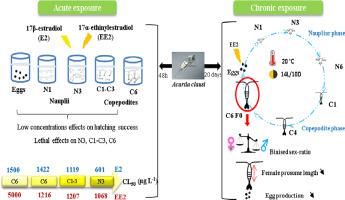Science of the Total Environment ( IF 8.2 ) Pub Date : 2021-10-07 , DOI: 10.1016/j.scitotenv.2021.150845 Emna Djebbi 1 , Mohamed Néjib Daly Yahia 2 , Emilie Farcy 3 , Olivier Pringault 4 , Delphine Bonnet 3

|
Estrogens, such as the 17β-estradiol (E2) and the 17α-ethinylestradiol (EE2), have been regarded as a global threat to aquatic ecosystems due to their pseudo-persistence, their high estrogenic activity and their toxicity towards non-target species. Data regarding their ecotoxicological effects on marine calanoid copepods are very scarce. In this study, the calanoid copepod Acartia clausi was used as a model organism for estrogens exposure in marine pelagic ecosystems. Lethal effects of estrogens on A. clausi life-stages (Embryos, one day old nauplii: N1, three day old nauplii: N3, copepodites: C1-C3 and adults: C6) were investigated using 48 h acute tests. Copepods showed stage-specific responses against E2 and EE2 acute exposure. The most resistant life stage was N1 with LC50 values > 1500 μg L-1 and >5000 μg L-1, respectively for E2 and EE2. For N3, C1-C3, and C6, sensitivity to estrogens decreased with age and survival was affected at concentrations above those detected in the environment reflecting low estrogens acute toxicity for these life stages. In contrast, embryonic stage revealed high vulnerability to E2 and EE2 acute effects. Embryos showed non-monotonic dose-response and hatching success was significantly reduced at low realistic concentrations of E2 (0.005, 0.5, and 5 μg L-1) and EE2 (0.05 and 5 μg L-1).
Survival, development and sex ratio of A. clausi to EE2 exposure at 1 and 100 μg L-1 were also determined during a life cycle experiment. Fitness of the females of the generation F0 was evaluated by measuring lifespan, prosome length and egg production. The main observed effects were the decrease of females’ prosome length, the feminization of the population and the reduction of the egg production for the generation F0 at 100 μg L-1 of EE2. This concentration is above those reported in the environment indicating the tolerance of A. clausi to EE2 at environmentally relevant concentrations.
中文翻译:

17β-雌二醇 (E2) 和 17α-乙炔雌二醇 (EE2) 对桡足类动物 克劳斯的急性和慢性毒性评估:对生存、发育、性别比例和繁殖的影响
雌激素,例如 17β-雌二醇 (E2) 和 17α-炔雌醇 (EE2),由于其假持久性、高雌激素活性和对非目标物种的毒性,已被视为对水生生态系统的全球威胁。关于它们对海洋类角足类动物的生态毒理学影响的数据非常稀少。在这项研究中,calanoid桡足类动物 Acartia clausi被用作海洋中上层生态系统中雌激素暴露的模式生物。雌激素对A. clausi生命阶段(胚胎、一天大的无节幼体:N1、三天大的无节幼体:N3、桡足类:C1-C3 和成体:C6)的致死作用使用 48 小时急性试验进行了研究。桡足类对 E2 和 EE2 急性暴露表现出阶段特异性反应。抗性最强的生命阶段是 N1 和 LC50 个值分别 > 1500 μg L -1和 >5000 μg L -1,分别用于 E2 和 EE2。对于 N3、C1-C3 和 C6,对雌激素的敏感性随着年龄的增长而降低,存活率在高于环境中检测到的浓度时受到影响,这反映了这些生命阶段的低雌激素急性毒性。相比之下,胚胎阶段显示出对 E2 和 EE2 急性效应的高度脆弱性。胚胎显示出非单调的剂量反应,并且在 E2(0.005、0.5 和 5 μg L -1)和 EE2(0.05 和 5 μg L -1)的实际低浓度下,孵化成功率显着降低。
在生命周期实验中还测定了1 和 100 μg L -1 下A.clausi与 EE2 暴露的存活率、发育和性别比。通过测量寿命、前体长度和产蛋量来评估 F0 代雌性的适应性。观察到的主要影响是雌性前体长度的减少、种群的女性化以及在 100 μg L -1 EE2 下F0 代的产蛋量减少。该浓度高于环境中报告的浓度,表明克劳斯曲霉在环境相关浓度下对 EE2的耐受性。











































 京公网安备 11010802027423号
京公网安备 11010802027423号